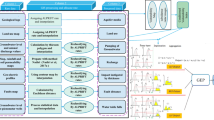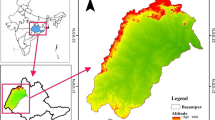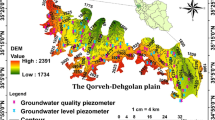Abstract
Land subsidence is mainly caused by excessive groundwater abstraction from aquifers. This study introduces Dynamic Subsidence Vulnerability Index (DSVI) by estimating possible land subsidence time variations by considering changes in groundwater level based on the ALPRIFT framework in Iran’s Hadishahr Plain, which is summarized in three modules. (i) Module I: mapping Subsidence Vulnerability Index (SVI) utilizing the ALPRIFT framework and optimization its weights by the Multiple Artificial Intelligence Models (MAIM) strategy; (ii) Module II: predicting groundwater level by Group Method of Data Handling (GMDH); and Module III: mapping DSVI by combining the results from Modules I and II. A two-pronged strategy is employed in MAIM: In Level 1, multiple models are derived from Sugeno Fuzzy Logic (SFL) and Support Vector Machin (SVM); and in Level 2, the outcomes of Level 1 models are combined by Artificial Neural Networks (ANN). According to the results: (i) ALPRIFT exhibits a correlation coefficient (r) of about 0.55 with corresponding measurements of land subsidence; (ii) using SVM and SFL to optimize the weights, r is raised to 0.83 and 0.74, respectively; (iii) the use of multiple models at Level 2 results in better performance than that of a single model at Level 1; and (iv) on the DSVI map, the central part of the plain is vulnerable at hotspot areas where groundwater is being improperly withdrawn from the Hadishahr Plain aquifer, increasing the risk of subsidence.








Similar content being viewed by others
Abbreviations
- SVI:
-
Subsidence Vulnerability Indices
- TSVI:
-
Dynamic SVI
- GWL:
-
Groundwater Level
- FL:
-
Fuzzy Logic
- SFL:
-
Sugeno Fuzzy Logic
- InSAR:
-
Interferometric Synthetic Aperture Radar
- GPR:
-
Ground-Penetrating Radar
- OW:
-
Observation well
- CSVI:
-
Conditioned SVI
- MF :
-
Membership Function
- BAF :
-
Basic ALPRIF framework
- RMSE:
-
Root Mean Squared Error
- r:
-
Correlation coefficient
- SVM:
-
Support Vector Machine
- MMs:
-
Multiple Models
- GMDH:
-
Group Method of Data Handling
- ANN:
-
Artificial Neural Networks
- AUC:
-
Area Under Curve
- MAIM:
-
Multiple Artificial Intelligence Models
- GPS:
-
Global Positioning System
- SC:
-
Subtractive Clutering
- MLP :
-
Multi layer perceptron
- SLC :
-
single look complex
- NSGA-II:
-
Non-dominated Sorting Genetic Algorithm-II
- R2 :
-
Coefficient of determination
- ROC:
-
Receiver Operating Characteristics
References
Anumba CJ, Scot DT (2001)Performance evaluation of a knowledge-basedsystem for subsidence management. Struct Surv 19:222–232
Avila-Olivera JA, Garduño-Monroy VH (2008)A GPR study of subsidence-creep -faultprocesses in Morelia, Michoacán, Mexico. Eng Geol 100(1–2):69–81
Beck BF (1986)A generalized genetic framework for the development of sinkholes and Karst in Florida, U.S.A. Environ Geol Water Sci 8:5. https://doi.org/10.1007/BF02525554
Candela T, Koster K, Stafleu J, Visser W, Fokker P (2020) Towards regionally forecasting shallow subsidence in the Netherlands. Proc. IAHS 382:427–431. https://doi.org/10.5194/piahs-382-427-2020
Chen B, Gong H, Chen Y, Li X, Zhou C, Zhu L, Duan L, Zhao X (2020) Land subsidence and its relation with groundwater aquifers in Beijing Plain of China. Science of The Total Environment 735:139111
Chiu S (1994)Fuzzy model identification based on cluster estimation. Intell Fuzzy Syst 2:267–278
Ciampalini A, Solari L, Giannecchini R, Galanti Y, Moretti S (2019)Evaluation of subsidence induced by long-lastingbuildings load using InSAR technique and geotechnical data: The case study of a Freight Terminal (Tuscany, Italy). Appl Earth Obs Geoinf 82:101925
Colazas XC, Strehle RW (1995)Subsidence in theWilmington Oil Field, Long Beach, California, USA. Dev Pet Sci 41:285–335
Deb K, Pratap A, Agarwal S, Meyarivan T (2002)A fast and elitist multiobjective genetic algorithm: NSGA-II. IEEE Trans Evol Comput 6(2):182–197
Unknown (2018) Report and available data. published by East Azerbaijan Regional Water Authority (EARWA), Iran.
Ebtehaj I, Bonakdari H, Zaji H, Azimi AH, Khoshbin F (2015)GMDH-typeneural network approach for modeling the discharge coefficient of rectangular sharp-crestedside weirs. Eng Sci Technol 18:746–757
Farlow SJ (1984)Self-organizingmethods in modeling: GMDH type algorithms. Marcel Dekker Inc, CrC Press
Galloway DL, Burbey TJ (2011)Regional land subsidence accompanying groundwater extraction. Hydrogeol 19(8):1459–1486
Galloway D, Jones D, Ingebritsen SE (1999)Land subsidence in the United State. U.S. Geological Survey, Circular 1182
Gambolati G (1975)Numerical models in land subsidence control. Comput Methods Appl Mech Eng 5(2):227–237
Gharekhani M, Nadiri AA, Khatibi R, Sadeghfam S (2021)An investigation into time-variantsubsidence potentials using inclusive multiple modelling strategies. J Environ Manage 294:112949
Gu K, Shi B, Liu C, Jiang H, Li T, Wu J (2018)Investigation of land subsidence with the combination of distributed fiber optic sensing techniques and microstructure analysis of soils. Eng Geol 240(5):34–47
Hanssen RF (2001)Radar Interferometry: Data Interpretation and Error Analysis. Springer Science & Business Media, Berlin
Hayashi T, Tokunag T, Aichi M, Shimada J, Taniguchi M (2009)Effects of human activities and urbanization on groundwater environments: an example from the aquifer system of Tokyo and the surrounding area. Sci Total Environ 407(9):3165–3172
Hiashi I, Tanaka H (1990)The fuzzy GMDH algorithm by possibility models and its application. Fuzzy Sets Syst 36(2):245–258
Ivakhnenko AG (1968)The Group Method of Data Handling –a rival of the Method of Stochastic Approximation. Soviet Automatic Control c/c of Avtomatika 1(3):43–55
Ivakhnenko AG (1978)The Group Method of Data Handling in Long-RangeForecasting. Technol Forecast Soc Change 12:213–227
Jafari F, Javadi S, Golmohammadi G, Karimi N, Mohammadi K (2016)Numerical simulation of groundwater flow and aquifer-systemcompaction using simulation and InSAR technique: Saveh basin, Iran. Environ Earth Sci 75(9):833
Khatibi R, Nadiri AA (2021)Inclusive Multiple Models (IMM)for predicting groundwater levels and treating heterogeneity. Geosci Front 12(2):713–724
Khatibi R, Ghorbani MA, Naghshara S, Aydin H, Karimi V (2020)Framework for ‘Inclusive Multiple Modelling’ with Critical Views on Modelling Practices -Applications to Modelling Water Levels of Caspian Sea and Lakes Urmia and Van. Hydro 587:124923
Kihm JH, Kim JM, Song SH, Lee GS (2007)Three-dimensionalnumerical simulation of fully coupled groundwater flow and land deformation due to groundwater pumping in an unsaturated fluvial aquifer system. J Hydrol 335(1–2):1–14
Kim D, Park GT (2005)GMDH-typeneural network modeling in evolutionary optimization, vol 3533. IEA/AIE, pp 563–570
Legates DR, McCabe CJ (1999)Evaluation the use of goodness-of-fitmeasures in hydrologic and hydro climate model validation. Water Resour Res 35(1):233–241
Li H, Philip CL, Huang HP (2001)Fuzzy neural intelligent systems: mathematical foundation and the applications in engineering. CRC Press, Boca Rato, p 392
Lorphensri O, Ladawadee A, Dhammasarn S (2011)Review of groundwater management and land subsidence in Bangkok, Thailand. In: Taniguchi M (eds)Groundwater and Subsurface Environments. Springer, Tokyo
Luo ZJ, Zeng F (2011)Finite element numerical simulation of land subsidence and groundwater exploitation based on visco-elastic-plasticbiot’s consolidation theory. J Hydrodynam 23(5):615–624
Malmir M, Javadi S, Moridi A, Neshat A, Razdar B (2021)A new combined framework for sustainable development using the DPSIR approach and numerical modeling. Geosci Front 12(4):101169
Moiwo JP, Tao F (2015)Satellite signal shows storage-unloadingsubsidence in North China. Hydrol Earth Syst Sci 12:6043–6075
Nadiri AA, Chitsazan N, Tsai FTC, Moghaddam AA (2014)Bayesian artificial intelligence model averaging for hydraulic conductivity estimation. J Hydrol Eng 19:520–532
Nadiri AA, Fijani E, Tsai FTC, Moghaddam AA (2013)Supervised committee machine with artificial intelligence for prediction of fluoride concentration. Hydroinformatics 15(4):1474–1490
Nadiri AA, Gharekhani M, Khatibi R, Moghaddam A (2017)Assessment of groundwater vulnerability using supervised committee to combine fuzzy logic models. Environ Sci Pollut Res 24(9):8562–8577
Nadiri AA, Gharekhani M, Khatibi R, Sadeghfam S, Asghari Moghaddam AA (2017)Groundwater vulnerability indices conditioned by Supervised Intelligence Committee Machine (SICM). Sci Total Environ 574:691–706
Nadiri AA, Khatibi R, Khalifi P, Feizizadeh B (2020) A study of subsidence hotspots by mapping vulnerability indices through innovatory ‘ALPRIFT’ using artificial intelligence at two levels. Bulletin of Engineering Geology and the Environment 79(8):3989–4003
Nadiri AA, Naderi K, Khatibi R, Gharekhani M (2019)Modelling groundwater level variations by learning from multiple models using fuzzy logic. Hydrol Sci J 64:210–226
Nadiri AA, Sedghi Z, Khatibi R, Gharekhani M (2017)Mapping vulnerability of multiple aquifers using multiple models and fuzzy logic to objectively derive model structures. Sci Total Environ 593:75–90
Nadiri AA, Taheri Z, Khatibi R, Barzegari G, Dideban K (2018)Introducing a new framework for mapping subsidence vulnerability indices (SVIs). Sci Total Environ 628:1043–1057
Nappoa N, Pedutob D, Polcaric M, Maria F, Ferrarioa F, Comercid V, Stramondoc S, Michettia AM (2021)Subsidence in Como historic centre (northern Italy): Assessment of building vulnerability combining hydrogeological and stratigraphic features, Cosmo-SkyMedInSAR and damage data. Int J Disast Risk Reduct 56:102115
Psimoulis P, Ghilardi M, Fouache E, Stiros S (2007)Subsidence and evolution of the Thessaloniki plain, Greece, based on historical leveling and GPS data. Eng Geol 90(1 2):55–70
Rahmani B, Javadi S, Shahdany MH (2019) Evaluation of aquifer vulnerability using PCA technique and various clustering methods. Geocarto International 36(1):1–24
Saatsaz M, Sulaiman WNA, Eslamian S, Javadi S (2013)Development of a coupled flow and solute transport modelling for Astaneh-Kouchesfahangroundwater resources, North of Iran. Int J Water 7(1–2):80–103
Sadeghfam S, Khatibi R, Dadashi S, Nadiri AA (2020)Transforming subsidence vulnerability indexing based on ALPRIFT into risk indexing using a new fuzzy-catastrophescheme. Environ Impact Assess Rev 82:106352
Sadeghfam S, Nourbakhsh Khiyabani F, Khatibi R, Daneshfaraz R (2020)A study of land subsidence problems by ALPRIFT for vulnerability indexing and risk indexing and treating subjectivity by strategy at two levels. Hydroinformatics 22(6):1640–1662
Sato PH, Abe K, Otaki O (2007)GPS-measuredland subsidence in Ojiya City, Niigata Prefecture, Japan. Eng Geol 67(3–4):379–390
Sfidari E, Kadkhodaie A, Ahmadi B, Ahmadi B, Faraji MA (2018)Prediction of pore facies using GMDH-typeneural networks: a case study from the South Pars gas field, Persian Gulf basin. Geopersia 8(1):43–60
Sossong AT (1973)Subsidence experience of Bethlehem Mines Corporation in Central Pennsylvania. In: Hargraves AJ (ed)Subsidence in mines-Proceedingsof symposium, 4th, Wollongong University, February 20-22, 1973. Australasian Institute of Mining and Metallurgy, pp 5.1–5.5
Swets JA (1988)Measuring the accuracy of diagnostic systems. Science 240(48–57):1285–1293
Tosi L, Teatini P, Strozzi T (2013)Natural versus anthropogenic subsidence of Venice. Sci Rep 3(1):1–9
Wang J, Deng Y, Ma R, Liu X, Guo Q, Liu S, Shao Y, Wu L, Zhou J, Yano T, Wana H, Huana X (2018)Model test on partial expansion in stratified subsidence during foundation pit dewatering. J Hydrol 557:489–508
Wu J, Shi X, Ye S, Xue Y (2010)Numerical Simulation of Viscoelastoplastic Land Subsidence due to Groundwater Overdrafting in Shanghai, China. J Hydrol Eng 15:3
Ye S, Luo Y, Wu J, Teatini P, Wang H, Jiao X (2015)Three dimensional numerical modeling of land subsidence in Shanghai. Proc IA372:443–448
Ye S, Luo Y, Wu J, Yan X, Wang H, Jiao X, Teatini P (2016)Three-dimensionalnumerical modeling of land subsidence in Shanghai, China. Hydrogeol J 24:695–709
Author information
Authors and Affiliations
Corresponding author
Additional information
Communicated by: H. Babaie.
Publisher’s Note
Springer Nature remains neutral with regard to jurisdictional claims in published maps and institutional affiliations.
Highlights
Dynamic Subsidence Vulnerability Indices (DSVI) is summarized in three Modules.
Module I: setting up an SVI and optimizing it by Multiple Artificial Intelligence Models (MAIM) strategy.
Module II: predicting groundwater level by Group Method of Data Handling (GMDH) model.
Module III: mapping DSVI by integrating the results from Modules I and II in Iran’s Hadishahr Plain aquifer.
Supplementary Information
Below is the link to the electronic supplementary material.
ESM 1
(DOCX 14.4 KB)
Rights and permissions
About this article
Cite this article
Nadiri, A.A., Habibi, I., Gharekhani, M. et al. Introducing dynamic land subsidence index based on the ALPRIFT framework using artificial intelligence techniques. Earth Sci Inform 15, 1007–1021 (2022). https://doi.org/10.1007/s12145-021-00760-w
Received:
Accepted:
Published:
Issue Date:
DOI: https://doi.org/10.1007/s12145-021-00760-w




